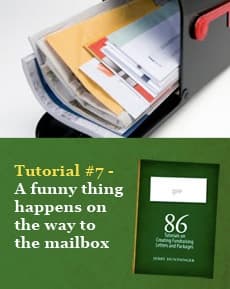Tutorial 7: A funny thing happens on the way to the mailbox
A letter owes part of its power to the way in which it is delivered. Perhaps your mail is delivered to your door. Do you ever rush to the door when you hear the mail hit the floor?
- Written by
- Jerry Huntsinger
- Added
- February 22, 2019

Or perhaps you have to walk or travel a distance to collect your mail. Do you ever feel your pulse quicken in anticipation of collecting your mail?
What will you find in the mail today? That catalogue you just ordered? A letter from an old and dear friend? Or a cheque?
Maybe you even prolong the experience by holding the envelope up to the light, so that you can see what might be inside. Silly, isn’t it? But that’s what people do. And if you haven’t done it, then, well, you’ve missed one of the subtle joys in life.
And, as you know, that joy is often so intense that, if you collect your mail and nothing is there that interests you, then you suddenly become angry and call everything you hold in your hand ‘junk mail’.
And the same can be said when you check your email and find it full of spam. You delete, delete, delete. Gleefully and angrily. But somewhat compulsively, you still carefully read each heading, just to make sure that you don’t delete something important.
It’s more difficult to throw away an envelope and the contents. It’s more difficult to reject a physical item that has a tactile feel about it.
Many people are privately interested in philanthropy. Often they won’t admit it, but through the mail they have had an experience of sharing their blessings with someone less fortunate.
But why through the mail? Why don’t they walk down to the local charity and hand out $20 bills? It’s because we are all desperately wanting to be connected – and yet we have fears of being connected. Why? Because we might be rejected. Strangely enough, that’s why direct mail fundraising works. People can be connected at a distance, with no fear of rejection. Perhaps you don’t want to be a volunteer or go from door to door collecting money for your favourite charity, or take a family in when their house burns down.
But isn’t the mailbox wonderful? You send your cheque and you feel really good about it. So good that the next time the charity writes to you, you may send another cheque. You’re eager to be connected. Perhaps the greatest connection of all is between you and an individual less fortunate.
While you are thinking about that, remember that your donor doesn’t think about you nearly as often as you think about your donor. In fact, the only time your donor thinks about you is probably when your letter arrives in the mailbox.
I know, I know ... your board says that long fundraising letters arriving several times a year puts pressure on your donors. Your board doesn’t know what it’s talking about. The truth is that your letters provide opportunities for your donors to be connected with people in need – and that’s the purpose of your direct mail programme, isn’t it, to provide that connection?
© SOFII Foundation 2010-2014.

















